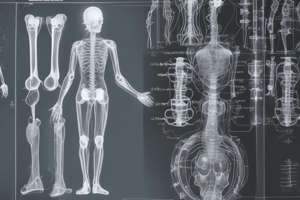Podcast
Questions and Answers
What is the maximum entrance exposure to the patient in the United States?
What is the maximum entrance exposure to the patient in the United States?
10 R/min
What mode of operation allows exposure rates of up to 20 R/min to the patient in the U.S.?
What mode of operation allows exposure rates of up to 20 R/min to the patient in the U.S.?
High Dose Rate Fluoroscopy
How is the high dose rate mode enabled in fluoroscopy systems?
How is the high dose rate mode enabled in fluoroscopy systems?
By stepping on a different pedal than the standard fluoroscopy pedal
What signal is required to sound when specially activated fluoroscopy is being used?
What signal is required to sound when specially activated fluoroscopy is being used?
Why is the need for high dose rate fluoroscopy questionable in practices that do not see an exceptionally high proportion of obese patients?
Why is the need for high dose rate fluoroscopy questionable in practices that do not see an exceptionally high proportion of obese patients?
What does the pulsed fluoroscopy system generate in terms of x-ray pulses per second?
What does the pulsed fluoroscopy system generate in terms of x-ray pulses per second?
How long is each pulse kept in pulsed fluoroscopy system, as compared to continuous fluoroscopy?
How long is each pulse kept in pulsed fluoroscopy system, as compared to continuous fluoroscopy?
What is the exposure time for each frame in pulsed fluoroscopy?
What is the exposure time for each frame in pulsed fluoroscopy?
How does pulsed fluoroscopy compare to continuous fluoroscopy in terms of reducing blurring from patient motion?
How does pulsed fluoroscopy compare to continuous fluoroscopy in terms of reducing blurring from patient motion?
What effect does the shorter exposure time in pulsed fluoroscopy have on image quality?
What effect does the shorter exposure time in pulsed fluoroscopy have on image quality?
Flashcards are hidden until you start studying
Study Notes
Image Intensifier (II) System
- The II system amplifies light intensity to produce a visible image, similar to a magnifying glass amplifying sunlight to start a fire.
- The output phosphor is very thin (1-2 µm) and produces a burst of green light when an electron strikes it.
Output Window and Light Propagation
- The output window is made of thick glass, and light exits from the back side of the phosphor into the glass.
- Light photons that hit the side of the window are absorbed by the black light absorber, while photons that reach the distal surface are focused using an optical lens and captured by a digital camera.
- Light propagates through the phosphor by diffusion, but in the clear glass window, it travels in straight lines until it reaches a surface.
Video Cameras
- In older fluoroscopy systems, a video camera is used to capture the image, and it consists of an electron beam swept in a raster fashion on the TV target.
- The TV target is a photoconductor, and its electrical resistance is modulated by varying levels of light intensity.
- The video signal is a voltage-versus-time waveform that is communicated to the video monitor, which synchronizes the raster scan pattern using sync pulses.
- The video monitor scans the electron beam in raster fashion, and the beam current is modulated by the video signal to produce an image on the screen.
TV Raster Scan
- The raster scan on the monitor is done in synchrony with the scan of the TV target.
- The electron beam "paints" lines on the screen from left to right, and then flies back to the left to start the next line.
- The term horizontal retrace refers to the beam moving back to the left at the end of each line, while the term vertical retrace refers to its movement from bottom to top.
Automatic Exposure Rate Control (AERC)
- The purpose of AERC is to keep the signal-to-noise ratio (SNR) of the image constant by regulating the x-ray exposure rate incident on the patient.
- AERC senses the light output from the II using a photodiode or the video signal and adjusts the x-ray output in response to the thickness of the patient.
- AERC circuitry can regulate the pulse width or pulse height of the x-ray pulses in pulsed-fluoroscopy systems.
Characteristics Unique to Image Intensifier Systems
- The function of the x-ray II is to convert an x-ray into a minified light image.
- Conversion factor is the ratio of the output luminance to the input exposure rate, measured in Cd sec m-2 mR-1.
- Brightness gain is the product of the electronic and minification gains of the II, and it ranges from about 2,500 to 7,000.
- Pincushion distortion occurs due to projecting the image from a curved input phosphor to a flat output phosphor.
Fluoroscopy Modes of Operation
- High-dose rate fluoroscopy allows exposure rates of up to 20 R/min to the patient in the U.S.
- Variable frame rate pulsed fluoroscopy produces a series of short x-ray pulses, reducing blurring from patient motion in the image.
- Pulsed fluoroscopy systems can generate 30 pulses per second, with each pulse kept to a shorter duration (e.g. 10 msec) and higher intensity (e.g. 6.6 mA).
Studying That Suits You
Use AI to generate personalized quizzes and flashcards to suit your learning preferences.




